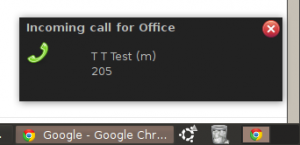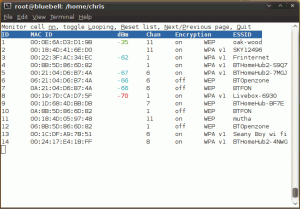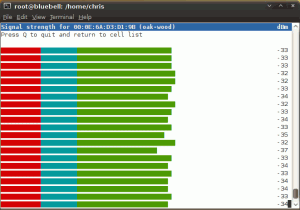There are several applications around for Windows users that offer popup notification of incoming calls to an Asterisk server, looking up the caller’s name in various Personal Information Managers (PIMs). Since I don’t use Windows, they’re not much use to me, so I wondered if there was anything available for Linux.
A Google a while back threw up this script by Olivier H. Beauchesne which looked promising. It does part of what I wanted—it generates a popup notification of incoming calls, but it makes no attempt to look up the name of the caller.
I considered writing something as a Thunderbird extension, but there seemed to be a couple of downsides to this approach:
- From recent experience of working with Thunderbird’s address book for a click2dial extension I knew that it doesn’t lend itself well to look ups keyed on phone numbers
- I wanted something that would always be running, irrespective of whether or not I’d fired up Thunderbird
I decided to have a go at hacking Olivier’s script, quite ambitious considering I’d never written anything in Python before.
It didn’t actually take much to get it to look up incoming numbers in a SQLite database. I then wrote a dirty Perl script to pull all the phone numbers out of my Thunderbird address book and populate the database. The Perl script was way to ugly to share and I always intended to tidy it up, but just never found the time. Until now.
A prolonged period off work sick has driven me to looking for things to keep my mind occupied, and so I’ve returned to this project. The Perl script has been scrapped. In it’s place I’ve written a Thunderbird extension named Squalit, a much neater solution. Squalit can export a single contact or an entire address book to the database, and can be configured to update the database periodically, ensuring that call popups and Thunderbird are always in sync.
I then turned my attention to the popup script itself. The original relied on libnotify and its Pyhon binding, pynotify. These are only available on Gnome based Linux distributions such as Ubuntu. I thought it would be useful to make everything more portable, so rewrote it to use a library I stumbled across by Daniel Woodhouse, gtkPopupNotify. After a fair few other changes I was left with a distant descendant of Olivier’s original script, which I’ve called callPopPy. callPopPy is portable enough that I’ve had it running on a Windows XP machine, and is doing just what I wanted on Ubuntu. The advantage of the two stage approach is that other utilities could be written to integrate callPopPy with other PIMs.
The combination of TBDialOut for click2dial with Squalit and callPopPy for call popup notification provides me with great integration between Thunderbird and my Asterisk server—I guess this is what is meant by CTI.



